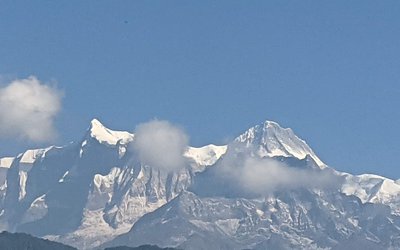
Nepal is one of the most vulnerable countries of the world in terms of natural disasters. However, Nepal has yet to make any progress in dealing with disasters. As UNDP is one of the major development partners supporting in disaster sector, SHOKO NODA spoke to New Spotlight on disaster related issues. Excerpts:
UNDP remains a major development partner supporting the disaster sector. How do you see Nepal's disaster preparedness?
UNDP has been supporting the Government of Nepal in the disaster risk management sector on a regular basis since the early 1990s, and even before that on an ad hoc basis. Although there is still a lot to be done, there are signs of progress. For example, there is a coordination mechanism through the National Emergency Operations Center in Kathmandu, which is being expanded to the regional and district levels, and16 districts already have District Emergency Operations Centers. First responders, including fire fighters and security forces, are better trained and equipped today than ever before. Similarly, national and district level preparedness and response plans have been developed. With UNDP’s support, the government has developed and finalized the National Strategy for Disaster Risk Management in Nepal (NSDRMN), which is a policy document guiding the country in the field of disaster risk management. While these preparations may not be adequate or perfect, I believe that we are heading in the right direction.
In which areas is UNDP supporting Nepal?
The overall strategic guidance on disaster risk reduction is provided by the National Strategy for Disaster Risk Management in Nepal (NSDRMN). Our role is to support the implementation of the recommendations made in the NSDRMN. In fact, I think that all major stakeholders should formulate their support activities around these recommendations. UNDP leads the Flagship Area 5 of the Nepal Risk Reduction Consortium (NRRC), which is about the Institutional and Legislative System related to disaster risk management. Hence, a priority area of our support is to ensure that disaster risk reduction is a national and local priority with a strong institutional basis for implementation. Other priority areas include strengthening disaster preparedness for effective response, reducing the underlying risks, and building a culture of safety and resilience through the use of knowledge, innovation and education. To provide the necessary support, we have been implementing a Comprehensive Disaster Risk Management Programme (CDRMP).
Some examples of our work include supporting the National Planning Commission to mainstream Disaster Climate Risk Management (D/CRM) concerns into the upcoming national plan, supporting to develop national disaster response framework, training 25 Armed Police Force first responders on flood and deep water search and rescue, providing equipment to fire services, supporting communities to be safe from water induced disaster, providing trainings to masons, and the reconstruction/repair of school blocks.
How do you see the present capability of Nepal to cope with a major disaster like earthquake?
It is difficult to predict a disaster, but when it occurs, it destroys lives and property as well as reverses development gains of several years. I come from Japan, which lies on a high seismic zone. We have learned very early on that preparedness is the best way to minimize the scale of devastation. Speaking from a personal context, I feel that Nepal still has a long way to be fully prepared for a big disaster. There has been a general lack of sensitization about the impacts of disaster. However, this appears to be changing. Nepal is certainly much better prepared today than a few years ago. The emergency response system has been strengthened through the establishment of the National Emergency Operations Centre (NEOC). District Emergency Operations Centres (DEOC) are currently being established in the high-risk districts. There is active advocacy for and support to response preparedness in schools and hospitals. Preparations for urban search and rescue are being made. In addition, the National Disaster Response Framework has been formulated which outlines the roles and responsibilities of all the involved stakeholders. The government is now taking leadership in disaster preparedness, and a lot of bilateral support is being provided by countries like Australia, the UK and the USA. However, huge gaps still exist. For example, until now, there are no emergency preparedness or response plans for majority of critical and life-line facilities, such as water supply, electricity, sewage, health, communication and transportation. Similarly, land use planning and bye laws are old and critically need updating. Furthermore, the government ministries and departments lack business continuity plans. The initiatives taken so far have to be expanded rapidly and new initiatives taken where needed.
Nepal lies in the earthquake prone zone, how do you see the level of awareness among the people?
The level of public awareness is slowly improving. People who have been affected by earthquakes have started demanding earthquake resistant construction technology and capacity building of local masons and builders. New house builders are getting more concerned and involved in their house construction. Building contractors and companies have started to take earthquake risks into consideration in construction projects. Private businesses are talking about earthquake safety and business continuity in their factories. Yet, as I said before, there are gaps. We are still not able to effectively implement the National Building Code (NBC). Code compliance is still considered a costly affair in construction. Studies show that 90 % of buildings in Nepal are owner/ mason built and most of these house owners and masons are ignorant about earthquake safe construction practices and building code compliance.
Climate change is going to severely affect Nepal in coming days particularly in the areas of natural disasters. How do you see the present level of preparedness to face such situation?
Nepal contributes almost zero in Green House Gas emission, however it is one of the countries hardest hit by the impacts of Climate Change. In 2010, it was ranked one of the most vulnerable countries to the negative impacts of climate change. Nepal has witnessed more than 24 Glacial Lake Outburst Floods (GLOF), and the present trend of swelling up of glacial lakes is alarming. No rain and too much of rain have aggravated the risk of drought as well as flash floods and landslides thereby increasing the vulnerability of the people having low or no coping capacity. A lot needs to be done to cope with such climate change induced disasters, and efforts need to be made at all levels from local to national. So far, UNDP had assisted the Government of Nepal to undertake vulnerability assessment and prepare a Vulnerability Map during the preparation of National Adaptation Programme of Activities (NAPA) in 2010, and is further supporting the government in designing targeted programmes to deal with different impacts of climate change.
How do you see the level of support given by Nepal's development partners in enhancing the capability of Nepal?
A dollar invested in disaster preparedness can save seven times the amount in post-disaster recovery work. Considering this, it is indeed important to increase international aid in the area of disaster preparedness. Globally, only 1% of international aid is spent on disaster preparedness, while just 10% would protect development gains. Nonetheless, Nepal’s disaster preparedness is seeing an increasing level of commitment from the development partners. Ten years ago, annual investments in disaster risk reduction were around $5 million dollars. Now, we are looking to around $40 million investment in a year. Coordination between the different development partners is also improving today. The Nepal Risk Reduction Consortium (NRRC) is a very good coordination mechanism between the government, the international community and other concerned authorities to work together on disasters. Through the NRRC all the different actors in disaster risk reduction share a common vision and goals. This is a remarkable feat for Nepal in the global arena. A good example of different actors working together is UNDP providing support to enhance emergency response system in Nepal by establishing emergency operations centres in different districts, and World Bank recently complementing this effort by purchasing search and rescue equipment for the Armed Police Force.
As Nepal is prone to disasters and earthquake, how do you see the importance of commemorating the Earthquake Day on Magh 2 (January 15)?
Events marking the Earthquake Safety Day are very important to raise awareness about both policy inadequacies and implementation challenges. This day has also been been instrumental in bringing actors together to discuss the issue of earthquake safety and make commitments. However, we need to ensure that commitments expressed on
such occasions are quickly translated into actions. Importantly, awareness raising events should be organized in schools so that awareness and preparedness starts early on in one’s life.
How do you visualize the level of devastation in Nepal, particularly Kathmandu, in case of a disaster over 8 Richter scale?
Nepal is sitting on top of a Fukushima (Japan 2011) sized earthquake with the vulnerability of Port au Prince (Haiti 2012). Experts believe that around 60% of the buildings in Kathmandu will be damaged or destroyed in an 8 Richter scale earthquake and more than 100,000 people will die, with millions made homeless. Sadly, this is the situation. On top of that, unlike Port au Prince, Nepal is landlocked and very far from the coast, and if the roads are damaged, it can be a big challenge for rescue and humanitarian assistance to reach here promptly like it did in Haiti. Without significant preparedness efforts, the impact will be devastating, especially considering that Kathmandu Valley is the economic, political and cultural centre of Nepal. The country may come to a complete standstill, with many decades of development gains lost in a single event. And this major concern should drive all stakeholders into more active preparedness work. UNDP is committed to play its part.
Since Nepal's development partners have been stressing the need to amend the current disaster act , is government taking initiative to tune disaster act making it timely?
Nepal has many pressing development priorities and others have been taking precedence over disaster risk reduction. However, since the development of the National Strategy for Disaster Risk Management in 2009, the government has been very active in disaster risk reduction. I believe that the government is also taking the disaster risk management (DRM) act quite seriously because several discussions have been taking place between different ministries, departments and local bodies, and the government has taken important steps towards improving the legislative aspects. I hope that this year we will have a new DRM act. However, I would also like to emphasize that that the actors should not wait for the DRM law, or for any other specific event for that matter, in order to do their work. Many priority activities can be, and are being, implemented without the DRM act, and I would like to commend the different ministries and departments of the government for taking this issue seriously and working with development partners to make Nepal disaster-resilient.
- TANAHU HYDROPOWER PROEJCT: A Significant Achievement
- Apr 15, 2024
- AMBASSADOR HANAN GODAR: Sharing Pain With A Nepali Family
- Mar 30, 2024
- VISIT OF KfW AND EIB TO NEPAL : Mission Matters
- Mar 25, 2024
- NEPAL BRITAIN SOCIETY: Pratima Pande's Leadership
- Mar 24, 2024
- NEPAL ARMY DAY: Time To Recall Glory
- Mar 15, 2024
















